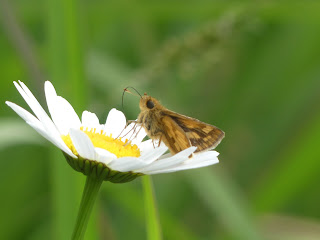Tufted Globetail
Here's a Tufted Globetail from last spring. They are hoverflies in the globetail genus, which gets its name because the males have tails (actually abdomens) that end in little globes. (In this species the tail is more "thick and rounded" rather than a globe.) If this individual was a female, the abdomen would have ended in more of a point. I generally expect these flies to have more prominent black stripes on the abdomen, though I'm not sure how much variation they can have.
If you were thinking this was a wasp, the hoverfly is doing its job; most hoverflies are wasp/bee mimics who "impersonate" stinging insects to get some of the protection their stinging look-alikes command. Although they can be found throughout most of North America, they're especially prevalent in Canada and the northern US.
Hoverflies are also called "flower flies" (also syrphids) because as adults they're basically pollinating insects who hang around flowering plants, in this case a Common Yarrow. Some other syrphids I've shown are the Margined Calligrapher Fly, Common Drone Fly, European Drone Fly, Transverse-banded Flower Fly, and Eastern Calligrapher.
Although they're vegetarians as adults, as larva they need their protein and eat small arthropods. Aphids are at the top of the menu but mites, thrips, and lepidopterans will do in a pinch.
 |
| June 17, 2023 at Duke Farms Photo 301010448, (c) jpviolette, some rights reserved (CC BY-NC) |



Comments
Post a Comment